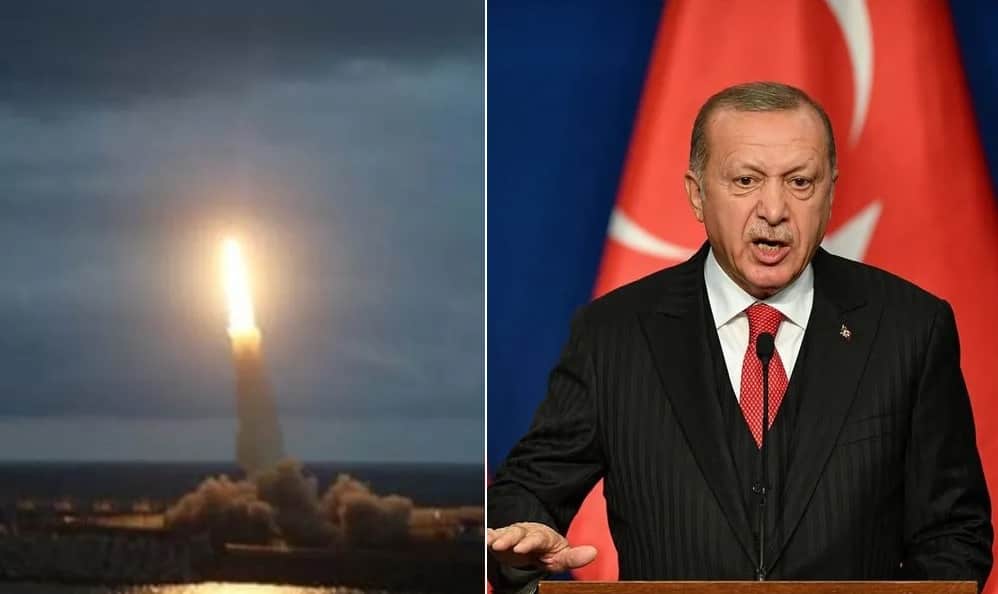Much has been heard and written about the test of the Tayfun ballistic missile by Turkey a few days ago. It is a short-medium range missile, which managed to hit a target at a distance of 561 kilometres in 458 seconds.
The launch of the missile was received with laudatory comments from the Turkish press, who pointed out that the capabilities of the missile are such that they can strike many places in neighbouring countries, including most of Greece.
This missile is expected to enter service within the next few years, after other tests have been carried out first. It will be added to an arsenal of smaller missiles like Yıldırım(150+ km) and Bora (300 km).
The successful (?) launch of the Tayfun whetted the appetite of Turkish President Recep Tayyip Erdoğan, with expert analysts in the neighbouring country claiming that Turkey has an even more impressive missile with a range of 3,000 kilometres in the works.
At the same time there are rumours that, in collaboration with the Russians, Turkey are preparing a hypersonic missile. This scenario is probably a long shot as the technology behind these weapons exceeds the existing capabilities of the Turkish defence industry.

It is obvious that the missiles and their tests are part of the more general tension that Erdoğan is causing with Greece for pre-election reasons. However, this does not mean that there should not be vigilance on our part.
Greece's reaction to this news was quite cool, with the Military Staff clarifying that it was already known and that there is a response plan .
The main weapon to deal with this whole situation is something for which the Turks have focused their aggression against Greece and are furiously demanding - the demilitarisation of our islands.
Their geographical distribution in the Aegean creates a shield which can hardly be penetrated by the existing weapon systems of the Turks. And with properly deployed air defences, any Turkish ballistic missiles and drones will be an easy task to deal with.

Greece can face this kind of weapon systems with the Patriot and the S-300 in Crete, while at the same time there are other weapon systems. It is known to everyone in NATO that Greece (unlike Turkey) has an excellent air defence, a real fortress that can cover most threats from the Turkish side.
At the same time, the strengthening of the Greek forces with weapons such as the new frigates and the Rafale (or the F-35 later), add an extra headache to Turkey.
Not only will they be able to face any ballistic attack, but they can also launch their own weapons (the missiles Meteor and Scalp are something that the Turkish military tremble at) deep in the Turkish hinterland.
In the air, the Turkish F16s now take off with the fear of the Rafales that can hit them from a long distance, while the much advertised Turkish drones will be detected and dealt with by various means, including the special "dome" from Israel.
The issue that could arise is in "saturation" attacks, i.e. the concentration of fire on a single target (such as a frigate).
There Turkey has a clear advantage as its defence industry is one of the fastest growing in the world, with billions in exports, huge production capabilities and constant development of its weapons systems.
Turkey can therefore produce large quantities of weapons, which may not be as sophisticated or reliable as those of more advanced countries, but they do not cease to be a powerful factor that gives impetus not only to the domestic economy but also to Turkish aggression towards all countries in the region.

Here Greece, with mistakes upon mistakes and complete obsolescence of the domestic defence industry over the decades this does not mean that in a potential crisis there are no weapons and planning (and the always necessary high sense ) to give the right response.
As long as the islands and the geographical blessing of the Aegean exist, the opposite side will always have a serious problem to solve.
And it will be practiced for a long time to come on maps with the range of some Protoleian missiles, for which it would be a surprise if they managed to make it over Lemnos before being shot down.
Panagiotis Tritaris is a columnist for News Auto.


